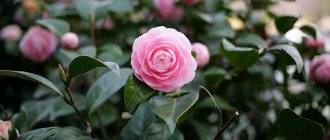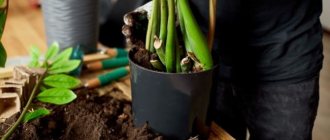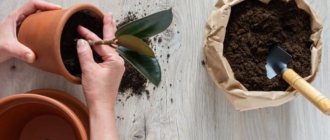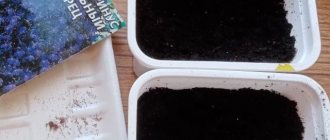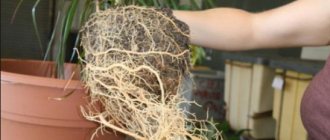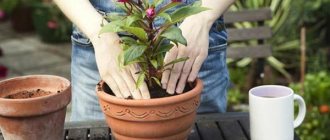Do we determine that an indoor flower needs a transplant?
Home flowers are constantly replanted. Young specimens are replanted every year, and already grown ones - once every 3-4 years.
Regular transplantation is carried out for the following reasons:
- Soil depletion. No matter how you feed the flowers, sooner or later the soil resource in the pot will be depleted. Therefore, the flowers will need to be replanted so that they continue to grow and develop normally. A sign of depletion of the soil mixture is slower growth, frequent diseases and poor flowering.
- Development of the root system. Like any living organism, a flower grows and gains mass. The root system develops and gradually entangles the entire earthen ball. This can be understood by the roots that protrude over the edges of the container or through the drainage holes.
But there are reasons why you need to transplant a flower into new soil urgently and without delaying the procedure:
- Overflow. You need to water your home flora regularly, but do it in moderation so that the moisture does not stagnate in the pot. The lack of drainage holes is also dangerous. Stagnation of moisture causes the roots to rot, and pathogenic microorganisms begin to multiply in the soil.
- Diseases and pests. If you find signs of fungal diseases or pests on a flower, then it must not only be treated with fungicides or insecticides, but also transplanted into a new container. In this case, it is necessary to completely clean the roots from old soil, in which parasite larvae or harmful microorganisms may remain.
ON A NOTE. In case of illness, infected specimens must be removed so as not to infect other crops.
Planting planning
According to astrologers, during the waxing moon phase, home flowers also accelerate their growth. This is due to the fact that the stems of green crops are filled with juice, which facilitates the rapid penetration of nutrients into the leaves and then into the buds. On the days of the waning moon, the nutritious juice remains in the green stems without penetrating into the bud itself. Therefore, the best period for planting indoor flowers will be the days of the waxing Moon. The seedlings grow especially beautiful at this time.
As for full moon days, flower growers recommend not planting flowers during this period. This is explained by the fact that the seedlings will not germinate. And during lunar eclipses, you should completely abandon any work on caring for green crops. It is believed that during the full moon the earth simply freezes.
In winter, it is especially important to choose the right time for planting tubers. To protect your plantings, it is recommended to use the lunar calendar of flowering indoor plants for December 2022, which you can familiarize yourself with now.
What indoor plants and flowers are usually replanted in February?
In February, daylight hours continue to increase and, feeling the spring, some flowers begin to wake up after a period of dormancy.
At this time, violet, dollar tree, mother-in-law's tongue, streptocarpus, impatiens, Decembrist, and a variety of ivies can be transplanted into new pots.
In addition, in the same month you can plant various tuberous or bulbous crops in new pots. For example, gloxinia, begonia. In early February, you can start forcing hyacinths by March 8th.
February is also quite suitable for planting new cuttings of geraniums, cacti and other succulents.
Caring for flowers in autumn
Replanting indoor plants in 2022: calendar
In September, plants that were outside are brought into the house. For prevention, leaves and stems are treated with systemic insecticides (Aktara) and fungicides (Maxim). To avoid loss of leaves, create good lighting when returning home.
Before the onset of cold weather, Indian chrysanthemum bushes are dug up in the garden, transplanted into flowerpots, and brought into the house. On a bright windowsill, flowering continues for a long time. Chrysanthemum needs 8 hours of daylight and a temperature of 18 °C. Gerbera begins to bloom in late summer and ends in autumn. Duration of active flowering is 3-4 months. At this time, gerbera needs a lot of light and moderate watering. If autumn is cloudy, the flower is illuminated and an LED phytolamp is installed.
Spectacular Hoya requires attention all year round. The liana comes from the tropics, so it loves warmth (27 °C) and moisture. In autumn, ivy leaves should be wiped with a damp cloth and sprayed. If these procedures are not enough, the vine will lose its decorative effect. Then Hoya will have to “bathe” - lower the pot into warm (35 °C) water for 15 minutes.
From mid-September, begonias begin to prepare for the dormant period:
- feeding for the last time;
- not allowed to bloom;
- the number of waterings is gradually reduced;
- At the end of October, watering is stopped.
In September-October, Saintpaulias are replanted, the substrate is changed, and old plants are rejuvenated. The cut tops are rooted. Crushed charcoal and perlite are added to the substrate. Before transplanting, violets are treated with Aktara and Fitoverm against pests and fungi.
In October, bulbous plants are planted for forcing by spring:
- tulips;
- daffodils;
- hyacinths.
The pots are kept in a cool (5-9 °C) room without light. The soil is moderately moistened, avoiding drying out and waterlogging.
In November, daylight hours are reduced to make tropical plants (hamedorea, howea, caryota) comfortable; phyto lamps are installed. Central heating radiators make the air in the room dry, which can cause spider mites to grow on plants. If a pest is detected, the bushes are sprayed with Actellik, and the plants are given a shower for prevention.
All work related to transplantation, cuttings, and pruning is best done on favorable days. Do not perform any manipulations with flowers during eclipses, full moons, and new moons. In 2022, unfavorable days will fall on the dates indicated below.
| Season | Month | Unfavorable dates |
| Winter | January | 15, 13, 28 |
| February | 11, 27 | |
| December | 4, 5-6, 19 | |
| Spring | March | 13, 28 |
| April | 12, 28 | |
| May | 11, 26 | |
| Summer | June | 10, 24 |
| July | 10, 24 | |
| August | 8, 22 | |
| Autumn | September | 7, 21 |
| October | 6, 21 | |
| November | 5, 19, 20-21 |
Taking into account the recommendations of astrologers, it is easier to grow beautifully flowering and decorative foliage indoor plants. Green pets will thank you for your love and care with exotic flowers (Callistemon, Metrosideros), cleanse the air of toxins (Eucalyptus, Myrtle, Dracaena, Pike Tail), and citrus fruits will reward you with fruits.
Favorable days for transplanting flowers in February 2022 according to the lunar calendar?
A good time to replant green pets is during the rising moon. It is best to start landing work when the earth's satellite passes through the constellation Virgo.
ON A NOTE. But the sign of Aquarius is considered unlucky for transplantation.
Therefore, plan your transplant on the following February dates: 5, 6, 7, 8, 9, 10, 11, 12, 13, 14, 18.
March
The beginning of spring will mark improved weather. Every day the sun warms up more and more, stimulating the flora to actively grow. March is a great time to plant new flora or sow seeds. The best days for this will be 21–30. In this case, it is better to carry out transplantation or breeding 10–11, 20–22, 25.
All water procedures according to the lunar calendar in March should be performed on 5–7, 15–17, 22–23. Fertilizing should be carried out on 5–6, 10, 12, 17, 22. The fight against pathogenic microflora and parasites, as well as pruning and rejuvenation, is best postponed to the following days: 6–8, 12, 28. Loosening the soil in March should be carried out on 1–2 , 13, 20, 26.
It is recommended to leave the vegetation alone on 3–4, 9, 14, 18, 31.
Florist's planting calendar for February of the year for every day, table
| February day | Constellation | Lunar day number | a brief description of |
| 1 | Aquarius | 1, 2 | New moon. Any landing is extremely undesirable. |
| 2 | Aquarius | 2, 3 | First day of the growing phase. Changing is highly undesirable throughout the day. |
| 3 | Fish | 3, 4 | The moon is waxing. Pisces is a controversial sign for planting. If possible, refuse the transplant. |
| 4 | Fish | 4, 5 | Waxing Crescent. Pisces is a controversial sign for planting. If possible, refuse the transplant. |
| 5 | Aries | 5, 6 | Waxing lunar phase. You can transplant the flowers into new containers. |
| 6 | Aries | 6, 7 | Waxing lunar phase. You can transplant the flowers into new containers. |
| 7 | Taurus | 7, 8 | Growing phase. Suitable for cuttings of geraniums, kalanchoes and propagation of other home flora. |
| 8 | Taurus | 8, 9 | The moon is waxing. Suitable for cuttings of geraniums, kalanchoes and propagation of other indoor plants. |
| 9 | Taurus | 9, 10 | The moon is waxing. Suitable for cuttings of geraniums, kalanchoes and propagation of other indoor plants. |
| 10 | Twins | 10, 11 | The moon is waxing. Neutral time, but since the moon is waxing, planting in new containers is allowed. |
| 11 | Twins | 11, 12 | Growing phase. Neutral time, but since the moon is waxing, planting in new containers is allowed. |
| 12 | Cancer | 12, 13 | The moon is waxing. Well suited for transplantation. |
| 13 | Cancer | 13, 14 | The moon is waxing. Well suited for transplantation. |
| 14 | Cancer | 14, 15 | The moon is waxing. Well suited for transplantation. |
| 15 | a lion | 15, 16 | The last day before the full moon. Not suitable for planting events. |
| 16 | a lion | 16, 17 | Full moon. Unlucky period. |
| 17 | Virgo | 17, 18 | Despite the zodiac sign, the day is not suitable for transplantation, since it is the first day of the waning moon after the full moon. |
| 18 | Virgo | 18, 19 | Despite the waning lunar phase, replanting indoor plants is allowed. |
| 19 | Scales | 19, 20 | Waning phase. Neutral time. Flowers can be replanted in an emergency. |
| 20 | Scales | 20, 21 | The moon is dying. Neutral time. Flowers can be replanted in an emergency. |
| 21 | Scales | 21, 22 | The moon is dying. Neutral time. Flowers can be replanted in an emergency. |
| 22 | Scorpion | 22 | Waning phase. A good day to replant cacti. |
| 23 | Scorpion | 22, 23 | Waning lunar period. A good day to replant cacti. |
| 24 | Sagittarius | 23, 24 | The moon is dying. It's better not to replant. |
| 25 | Sagittarius | 24, 25 | The moon is dying. It's better not to replant. |
| 26 | Capricorn | 25, 26 | The moon is dying. Neutral period for planting. |
| 27 | Capricorn | 26, 27 | The moon is dying. Neutral period for planting. |
| 28 | Aquarius | 27, 28 | The moon is dying. Unlucky constellation Transfer prohibited. |
Impact of zodiac signs
Oddly enough, the constellation in which zodiac the Moon is located also plays a big role. According to the degree of negative and positive influence on life processes, all zodiac signs are divided into two groups - water, which favors fertility, and fire, which has a negative impact. The group of water signs includes the constellations Pisces, Cancer, Scorpio, Virgo and Taurus.
It is at the moment of their direct influence on the Moon that the vital energy of all living things is at the very peak of its capabilities and contains enormous potential. Therefore, experienced gardeners try to plant on the most suitable days.
Fire signs include all the others - Leo, Sagittarius, Libra, Aquarius, Aries, Capricorn and Gemini. During the dominance of these signs, it is strictly forbidden to plant, as there is a high probability of getting a weak or non-viable plant. In addition, the consequences of gardening work carried out during this period may affect future plantings.
The influence of the moon sign and phase on the transplantation of indoor flowers and plants?
According to the lunar calendar, the success of flower transplantation is influenced not only by the lunar phases, but also by the zodiac sign.
If the night star increases day by day in the night sky, then this is the most favorable period to transplant flowers in February. Favorable days according to the lunar calendar occur in the first half of the month.
If the night star gradually decreases, then this is rather a neutral time. You can only replant if you are unable to carry out planting work during the growing phase. But in no case should it be replanted under the signs of Pisces and Aquarius.
The full moon and new moon are the worst times for transplantation.
Now let's talk about the zodiac constellations.
- Aries – this day is not the most favorable day, but under the waxing moon you can replant flowers.
- Taurus is a good period for cuttings from indoor plants.
- Gemini is a neutral period.
- Cancer is well suited for transplantation, especially in the growing phase.
- Leo is a neutral period.
- Virgo is a good time to transplant flowers in February 2022. According to the lunar calendar, days under this constellation are considered favorable in any lunar phase except the full moon and new moon.
- Libra is a neutral constellation.
- Scorpio is a generally neutral constellation, but on this day, prickly succulents tolerate replanting well.
- Sagittarius is not a very favorable constellation for planting in new containers.
- Capricorn is a favorable sign for transplantation during the waxing moon.
- Aquarius is the worst constellation for landing events.
- Pisces is an ambiguous influence. While it is possible to transplant on a waxing moon, it is strictly prohibited on a waning moon.
The nuances of planting flowers
Of course, the procedure for planting plants has its own nuances. Strict adherence to the established rules will help even novice gardeners grow lush flowers on the windowsill. Particular attention should be paid to the planting procedure, as well as fertilizer. It is these procedures that become decisive indicators in the flowering of vegetation. With proper care, an indoor flower will always be strong, will withstand unfavorable conditions and will not get sick. Therefore, it is worth studying the main nuances, as well as the sharp corners of such procedures.
Features of sowing seeds
Sowing seeds is a whole science. Of course, soaking and sowing seeds should only be done according to the Lunar calendar. Specially selected dates will help achieve the healthiest and strongest plants. In order to sow the seeds of indoor plants, small containers with a depth of at least 6-8 centimeters are suitable. The width and dimensions generally depend on the number of seeds planted. Additional landing details:
- The container for planting must be treated if plants were grown in it. If the container is new, it does not need to be processed.
- It is important to make drainage holes at the bottom of the container.
- The processing and germination procedure directly depends on the variety and type of plant.
- You also need to properly organize the lighting of the sprouts.
Only if all the nuances are properly observed can you grow beautiful and lush flowers. But it is worth considering that not all flowers germinate through seeds. A number of varieties are best grown from cuttings or small shoots. Since seed germination is a labor-intensive process.
Fertilizer use
The astrological calendar also suggests a daily schedule for fertilizing plants. As a rule, fertilizers are used to strengthen plants. General rules and nuances of feeding indoor plants:
- Before the onset of the dormant period, the amount and concentration of fertilizers is reduced.
- To avoid burning the roots, the fertilizer substrate must be moistened.
- It is better to feed frequently, but in small doses.
- Before the final introduction of a particular complementary food, it must first be tested in a small dosage.
- It is better to apply little fertilizer than too much. Feeding plants is an important process, so it is better to choose food for a specific plant.
Reference! Natural complementary foods, such as ash and humus, are also best added according to the Lunar calendar.
All living organisms on Earth are dependent on the lunar cycle; plant growth is related to the phase in which the satellite is located. Experienced gardeners and flower growers recommend following all the suggested tips. After all, if you plant according to the established dates, the plants will grow and look noticeably better.
Common mistakes
- The soil is not updated. During planting work, new soil must be used. First, the new soil has more nutrients. Secondly, the old substrate may be infected with parasites or fungal spores.
- No drainage. The drainage system is very important. It prevents excess water from accumulating in the pot. When planting a flower in a new container, it is important to make drainage holes and add fine expanded clay or pebbles.
- Planting work is carried out inaccurately. When replanting, you must act very carefully so as not to damage the roots or break the stems of the flower. If the plant has grown deeply into the container, it is better to carefully cut it than to try to pull the flower out of the pot.
Caring for flowers in autumn
Florist's lunar calendar for 2022 by month
In September, plants that were outside are brought into the house. For prevention, leaves and stems are treated with systemic insecticides (Aktara) and fungicides (Maxim). To avoid loss of leaves, create good lighting when returning home.
Before the onset of cold weather, Indian chrysanthemum bushes are dug up in the garden, transplanted into flowerpots, and brought into the house. On a bright windowsill, flowering continues for a long time. Chrysanthemum needs 8 hours of daylight and a temperature of 18 °C. Gerbera begins to bloom in late summer and ends in autumn. Duration of active flowering is 3-4 months. At this time, gerbera needs a lot of light and moderate watering. If autumn is cloudy, the flower is illuminated and an LED phytolamp is installed.
Spectacular Hoya requires attention all year round. The liana comes from the tropics, so it loves warmth (27 °C) and moisture. In autumn, ivy leaves should be wiped with a damp cloth and sprayed. If these procedures are not enough, the vine will lose its decorative effect. Then Hoya will have to “bathe” - lower the pot into warm (35 °C) water for 15 minutes.
From mid-September, begonias begin to prepare for the dormant period:
- feeding for the last time;
- not allowed to bloom;
- the number of waterings is gradually reduced;
- At the end of October, watering is stopped.
In September-October, Saintpaulias are replanted, the substrate is changed, and old plants are rejuvenated. The cut tops are rooted. Crushed charcoal and perlite are added to the substrate. Before transplanting, violets are treated with Aktara and Fitoverm against pests and fungi.
In October, bulbous plants are planted for forcing by spring:
- tulips;
- daffodils;
- hyacinths.
The pots are kept in a cool (5-9 °C) room without light. The soil is moderately moistened, avoiding drying out and waterlogging.
In November, daylight hours are reduced to make tropical plants (hamedorea, howea, caryota) comfortable; phyto lamps are installed. Central heating radiators make the air in the room dry, which can cause spider mites to grow on plants. If a pest is detected, the bushes are sprayed with Actellik, and the plants are given a shower for prevention.
All work related to transplantation, cuttings, and pruning is best done on favorable days. Do not perform any manipulations with flowers during eclipses, full moons, and new moons.
In 2022, unfavorable days will fall on the dates indicated below.
| Season | Month | Unfavorable dates |
| Winter | January | 11.01, 25.01, 26.01 |
| February | 9.02, 21.02-23.02 | |
| December | 14.12, 18.12, 19,12, 30.12 | |
| Spring | March | 10.03, 19.03-21.03, 24.03 |
| April | 8.04, 16.04, 17.04 | |
| May | 7.05, 13.05, 14.05, 23.05 | |
| Summer | June | 6.06, 9.06-11.06, 21.06 |
| July | 5.07, 7.07, 8.07,21.07 | |
| August | 3.08, 4.08, 19.08, 30.08, 31.08 | |
| Autumn | September | 1.09, 2.09, 17.09, 27.09, 28.09 |
| October | 2.10, 17.10, 24.10, 25.10, 31.10 | |
| November | 15.11, 20.11, 21.11 |
Taking into account the recommendations of astrologers, it is easier to grow beautifully flowering and decorative foliage indoor plants. Green pets will thank you for your love and care with exotic flowers (Callistemon, Metrosideros), cleanse the air of toxins (Eucalyptus, Myrtle, Dracaena, Pike Tail), and citrus fruits will reward you with fruits.
Useful articles from the “Calendars” section:
Useful articles for gardeners:
- Jerusalem artichoke
- The best carrot varieties for 2022: the most productive, tasty, juicy, sweet
- The best varieties of cucumbers for 2022: the most delicious and productive
- When to plant radishes in 2022: planting dates
- Potassium humate: what is it, instructions for use, dosage
- Feeding blue ones after planting in the ground: how to feed eggplants, the best means
- The most beautiful perennials for the garden and dacha: unpretentious, photos with names
- Feeding strawberries during flowering and fruiting: what to feed, the best means
- Planting cabbage in June 2022 according to the lunar calendar: favorable days
- How to feed cabbage after planting in open ground in 2022: timing, best means
Answers to frequently asked questions
Can I use soil from an old pot?
Some gardeners add old soil when planting. This is not entirely correct, since by the time of transplantation the substrate can no longer provide the plant with the required amount of nutrients. That is why new soil is always poured into the pot.
Is it possible to use garden soil for replanting?
Many domestic flower crops come from hot countries. Our soil is too dense and heavy for them. Most flowers require a light, loose nutrient substrate, often containing peat or sand.
Therefore, it is better to buy flower soil in the store and replant it into it.
Caring for flowers in autumn
In September, plants that were outside are brought into the house. For prevention, leaves and stems are treated with systemic insecticides (Aktara) and fungicides (Maxim). To avoid loss of leaves, create good lighting when returning home.
Before the onset of cold weather, Indian chrysanthemum bushes are dug up in the garden, transplanted into flowerpots, and brought into the house. On a bright windowsill, flowering continues for a long time. Chrysanthemum needs 8 hours of daylight and a temperature of 18 °C. Gerbera begins to bloom in late summer and ends in autumn. Duration of active flowering is 3-4 months. At this time, gerbera needs a lot of light and moderate watering. If autumn is cloudy, the flower is illuminated and an LED phytolamp is installed.
Spectacular Hoya requires attention all year round. The liana comes from the tropics, so it loves warmth (27 °C) and moisture. In autumn, ivy leaves should be wiped with a damp cloth and sprayed. If these procedures are not enough, the vine will lose its decorative effect. Then Hoya will have to “bathe” - lower the pot into warm (35 °C) water for 15 minutes.
From mid-September, begonias begin to prepare for the dormant period:
- feeding for the last time;
- not allowed to bloom;
- the number of waterings is gradually reduced;
- At the end of October, watering is stopped.
In September-October, Saintpaulias are replanted, the substrate is changed, and old plants are rejuvenated. The cut tops are rooted. Crushed charcoal and perlite are added to the substrate. Before transplanting, violets are treated with Aktara and Fitoverm against pests and fungi.
In October, bulbous plants are planted for forcing by spring:
- tulips;
- daffodils;
- hyacinths.
The pots are kept in a cool (5-9 °C) room without light. The soil is moderately moistened, avoiding drying out and waterlogging.
In November, daylight hours are reduced to make tropical plants (hamedorea, howea, caryota) comfortable; phyto lamps are installed. Central heating radiators make the air in the room dry, which can cause spider mites to grow on plants. If a pest is detected, the bushes are sprayed with Actellik, and the plants are given a shower for prevention.
All work related to transplantation, cuttings, and pruning is best done on favorable days. Do not perform any manipulations with flowers during eclipses, full moons, and new moons.
In 2022, unfavorable days will fall on the dates indicated below.
| Season | Month | Unfavorable dates |
| Winter | January | 11.01, 25.01, 26.01 |
| February | 9.02, 21.02-23.02 | |
| December | 14.12, 18.12, 19,12, 30.12 | |
| Spring | March | 10.03, 19.03-21.03, 24.03 |
| April | 8.04, 16.04, 17.04 | |
| May | 7.05, 13.05, 14.05, 23.05 | |
| Summer | June | 6.06, 9.06-11.06, 21.06 |
| July | 5.07, 7.07, 8.07,21.07 | |
| August | 3.08, 4.08, 19.08, 30.08, 31.08 | |
| Autumn | September | 1.09, 2.09, 17.09, 27.09, 28.09 |
| October | 2.10, 17.10, 24.10, 25.10, 31.10 | |
| November | 15.11, 20.11, 21.11 |
Taking into account the recommendations of astrologers, it is easier to grow beautifully flowering and decorative foliage indoor plants. Green pets will thank you for your love and care with exotic flowers (Callistemon, Metrosideros), cleanse the air of toxins (Eucalyptus, Myrtle, Dracaena, Pike Tail), and citrus fruits will reward you with fruits.
Useful articles from the “Calendars” section:
Useful articles for gardeners:
- Scab on a pear: description, how to get rid of it, how to treat it, prevention
- Caring for basil at home
- Melissa
- Growing grapes from cuttings: how to grow, care, planting
- Caring for roses in autumn: preparing for winter, pruning
- Planting honeysuckle in the fall: when to plant, timing, cultivation and care
- Preparing pepper seeds for planting as seedlings: methods, sowing
- When to plant seedlings in 2022: sowing dates, favorable days
- Favorable days for planting onions in 2022: when to plant
- Sowing turnips and radishes in 2022: when to plant, timing
